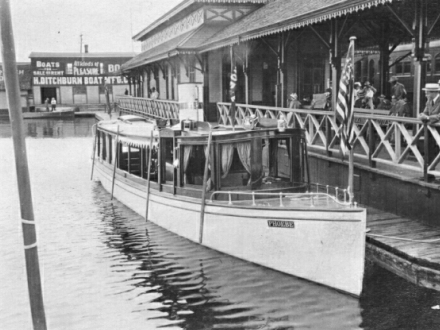We felt lazy and relaxed. How could you not? The breezes are balmy, the living is laidback, and everything revolves around the sparkling water. And yet there is an unmistakable energy here, a vibrancy that says Gravenhurst’s Muskoka Wharf is the place to be.

Gravenhurst’s fortunes have always been linked to its waterfront. The history of Gravenhurst and its wharf march in lock step, developments in one having always affected the other. As went the Muskoka Wharf, so went Gravenhurst.
In the very beginning, the wharves built by James McCabe along the shores of Muskoka Bay served as stepping-off points into the wilds of Muskoka. Businesses in the form of hotels, taverns, stores and shipping interests began to cater to this slow but steady trickle of homesteaders, and consequently Gravenhurst developed along the shores of Lake Muskoka. It should therefore come as little surprise that Gravenhurst was originally known as McCabe’s Landings.
Activity along the Wharf reached a fevered pitch once the railway reached Gravenhurst in August 1875. On September 28, the first railway hissed and steamed its way into town. Two months later, a spur line down to the lakeshore was built.
It was this time that Muskoka Wharf truly was born. The southestern shoreline of Muskoka Bay was artificially extended with massive cribwork and fill to form a true wharf within the sheltered inlet.
After the railway was introduced, the wharf was a bon to industry and settlement in the region. Hundredes if not thousands, of settlers passes through every year for almost two decades, and were joined by an equal number of summr tourists.
Muskoka Wharf remained a hive of activity and industry until the dawn of the automobile in the 1930s, driving trains, steamships and the wharf to the edge of extinction. One by one, trains to Gravenhurst were cancelled and ships were retired from service.
It was inevitable that Gravenhurst would feel the loss, and not just on a sentimental level. The wharf had brought prosperity, luring thousands of tourists even in the waning years of the steamship era. In time Gravenhurst recovered, but it was never the same.
Unitl now, that it. In the last decade, an 89-acre development featuring boutique shops, restaurants, playgrounds and sporting fields, and lakeside boardwalks has restored a luster to Muskoka Wharf not seen since the days when Gravenhurst was known as the Gateway to Muskoka.
The development has transformed a moribund waterfront into perhaps the coolest spot in Muskoka. At one point in the past Gravenhurst was the heart f the region. Its pulse slowed for a while with the demise of the lumber industry and the decline of the steamships, but now the beat is most definitely back.
This story is a collection from the original article written by Andrew Hind and Maria Da Silva.
For a full copy of the story read Andrew Hind and Maria Da Silva’s article on page six of Sideroads of Muskoka – Summer 2011.








